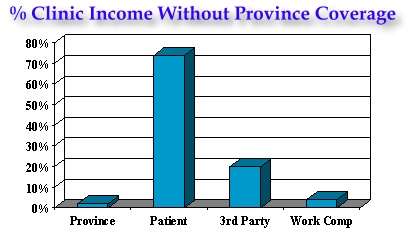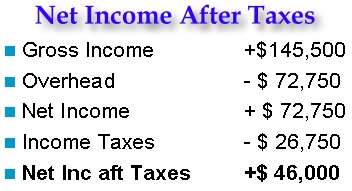

Chiropractic in Canada
CURRENT CHIROPRACTIC ENVIRONMENT
- The population of Canada is 30 million people (Stats Canada, 1999), there are 5000 practicing chiropractors (CCA, 1999). Therefore the D.C. to population ratio for Canada is 1: 6000. This ratio has been steadily declining over the last decade.
- The current chiropractic utilization rate is estimated at 12.5 % of the Canadian population (CCA, 1999). Unfortunately, this rate has not been increasing enough to match the increase in chiropractors. In fact, the rate has remained virtually unchanged over the last 10 years.
- The average active chiropractor is 42 years old, been in practice for 14 years, works 49 weeks a year, 41 hours a week and 83 % are male (JCCA, 1997).
- 17.5 % of chiropractors had more than one practice location (JCCA, 1997).
- The average chiropractor treats 7400 patients a year, 159 patients a week, 32 patients a day, 4 patients per hour and sees 6 new patients a week (JCCA, 1997).
- Chiropractors reported employment as follows: 69 % sole proprietorship, 21 % Associateship, and 12 % Partnership (JCCA, 1997). These are some of the different type of business structures that are available to you when setting up and operating your practice.
- Work environment: 85 % private chiropractic office, 19 % multidisciplinary office, 1.5 % educational facility and .5 % hospital (JCCA, 1997). The multidisciplinary setting is becoming a larger percentage as patients demand a more comprehensive approach to treatment and doctors realize the increasing demand for this type of clinic.
- Chiropractors treat 86 % of their patients for primary conditions of a neuromusculoskeletal nature (JCCA, 1997).
- Chiropractors utilize Diversified technique 77 % of the time (JCCA, 1997).
- Forty-six per cent (46 %) of chiropractors take their own x-rays. In the US, this figure is closer to 90 % because the insurance payment system covers the majority of x-rays taken at a chiropractors office.
- Chiropractors referral sources were as follows: Patient referral (PR) 59 %, Medical doctor (MD) 9 %, Walk-in (WI) 8 %, Personal contact (PC) 7 %, Advertisement (AD) 7 %, Other health professional (HP) 4 %, Another chiropractor (DC) 4 %, Patientís employer (PE) 2 %, and Medical specialist (MS) 1.0 % (JCCA, 1997). If you start a new clinic, you will be missing out on the largest referral source, patient referral (59 %), because you do not have any patients.

- In provinces with provincial health coverage for chiropractic services (BC, AB, SK, MB, ON), 40 % of clinic income was from the provincial plan (Province), 45 % directly from the patient (Patient), 10 % from a third party payer (3rd Party) and 6 % from a workers compensation board (Work Comp) (JCCA, 1997). As you can see the patientsí responsibility is less than half.

- In provinces without provincial health coverage for chiropractic services (QB, NF, NS, NB, PEI), 2 % of clinic income was from provincial plans (Province), 74 % directly from patient (Patient), 20 % from a third party payer (3rd Party) and 4 % from a workers compensation board (Work Comp) (JCCA, 1997). As you can see the patientsí responsibility is nearly three quarters.

- The average total fee per initial visit for all adult patients was $43 and the average total fee per subsequent visit was $23.50. This information is very important to have when you are trying to budget accurately your clinic gross income and cash flows.
- Seventy-one (71 %) of chiropractors reported that their patient load was below the level they would like it to be, 28 % were satisfied with there patient load. This statistic suggests that existing chiropractors will continue to compete with new chiropractors for patients.
- The greatest portion of chiropractors reported a gross annual income (before overhead and taxes) of between $100,000 and $150,000 (JCCA, 1997).
- The average gross income for all chiropractors was $145,500, but the longer in practice, the greater the income. The average gross income for those in practice less than three years was $60,000 (Figure 5, OIC). The average gross income of $145,500 is something that you will attain in the future but usually not for 2-4 years.
- Just over half of the chiropractors reported overhead between 40 % and 60 % of gross income, for an average of approximately 50 % (JCCA, 1997). Overhead will be a larger percentage in the first few years until average industry incomes are reached.
- The greatest portion of chiropractors (38 %) reported net income (after overhead, before taxes) between $40,000 and $60,000 of gross income (JCCA, 1997).
- Therefore if average gross income of a chiropractor is $145,500, and the average overhead is 50 % of gross income, then average net income is $72,000. After taxes of approximately $27,000, the average chiropractor had $45,000 remaining for living costs.

Copyright © 2001
Chirostart
All rights reserved.
| Home / Contact Us | Chiropractic in Canada | Chiropractic by Province | Business Plan Information | Career Options |
| Classifieds | Buyer's Guide | Consulting Services | Seminar Outline and Schedule | Member's Only |